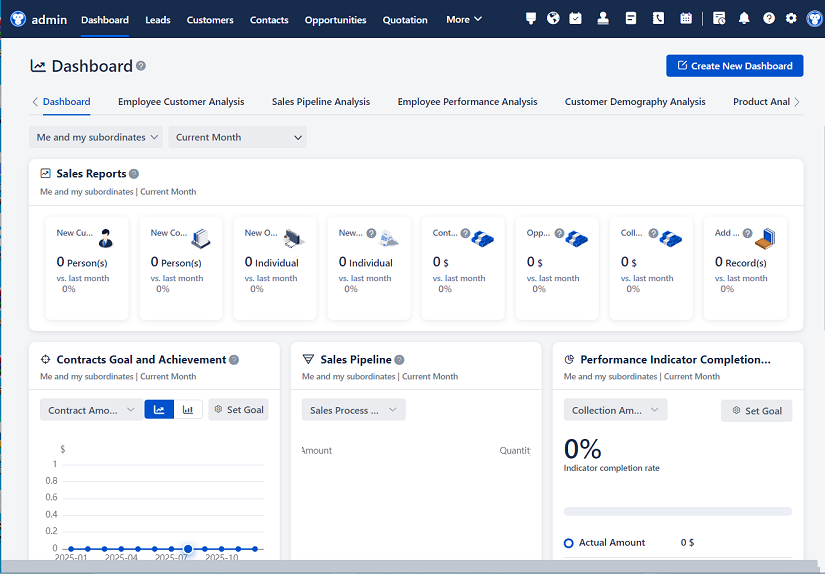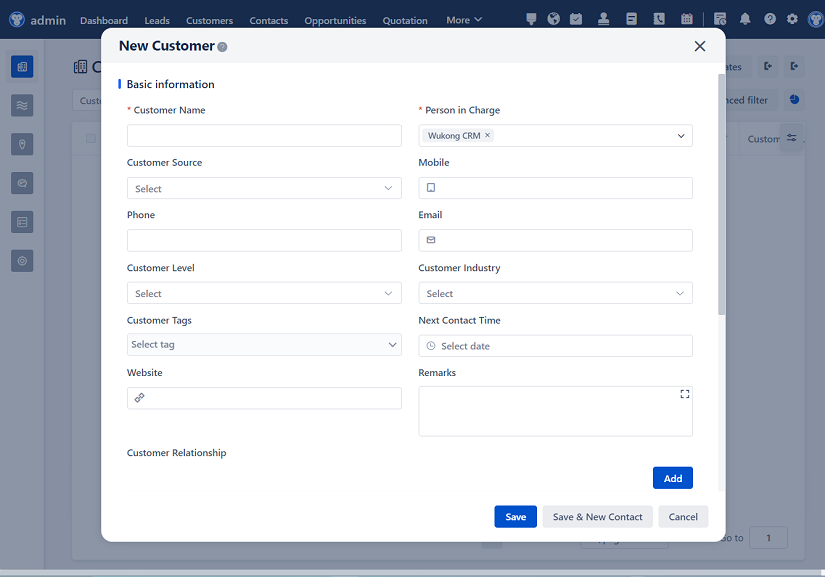
△Click on the top right corner to try Wukong CRM for free
Hey there! So, you're interested in CRM system database design, huh? That's a pretty cool topic, and I'm glad you asked. Let's dive right into it, shall I?

First things first, when we talk about a CRM (Customer Relationship Management) system, we're really talking about a tool that helps businesses manage their interactions with customers and potential customers. It’s like having a super organized friend who remembers all the little details about your friends and family, but for a business. You know, the kind of friend who can tell you what your cousin's favorite ice cream flavor is, even if you haven't seen them in years.

Now, the heart of any CRM system is its database. Think of it as the brain of the operation. It stores all the information, from customer names and contact details to purchase history and preferences. It’s where all the magic happens, and it needs to be designed just right to make sure everything runs smoothly.
So, how do we go about designing this database? Well, it starts with understanding what exactly you need to store. Imagine you’re planning a big party, and you need to keep track of all the guests, what they like, and what they don’t. You’d probably start by making a list, right? In the same way, we need to list out all the data points we want to capture in our CRM system.

Let’s say we’re a small e-commerce company. We might want to store things like customer names, email addresses, phone numbers, and shipping addresses. But that’s just the basics. We also want to know what products they’ve bought, when they bought them, and maybe even what they were looking at on our website. It’s like keeping a detailed journal of every interaction, so we can remember and use that information later.
Once we have our list, we need to think about how these pieces of information relate to each other. For example, a customer can have multiple orders, and each order can have multiple items. This is where we start to draw those fancy diagrams, like entity-relationship (ER) diagrams. These diagrams help us visualize how different parts of the database are connected. It’s a bit like drawing a map of your house, showing which rooms are next to each other and how you can get from one place to another.
Next up, we need to decide on the tables and fields. Tables are like the different sections of your notebook, and fields are the columns in those sections. For instance, we might have a "Customers" table with fields like "CustomerID," "FirstName," "LastName," "Email," and "Phone." Then we might have an "Orders" table with fields like "OrderID," "CustomerID," "OrderDate," and "TotalAmount." Each table and field needs to be carefully thought out, so we don’t end up with a mess of data that’s hard to manage.
But wait, there’s more! We also need to think about how we’re going to ensure the data stays clean and consistent. This is where constraints come in. Constraints are like the rules we set to make sure the data makes sense. For example, we might have a rule that says a customer’s email address must be unique, or that an order date can’t be in the future. These rules help us avoid mistakes and keep our data reliable.

Another important thing to consider is indexing. Indexes are like the bookmarks in a book. They help us find specific pieces of information quickly. For example, if we frequently search for customers by their last name, we might create an index on the "LastName" field. This way, when we look for a customer, the system doesn’t have to scan through every single record; it can jump straight to the right place. It’s a bit like having a well-organized filing cabinet where you can find what you need in no time.
And let’s not forget about security. We need to make sure that only the right people can access and modify the data. This means setting up user roles and permissions. For example, a salesperson might be able to view and update customer information, but they shouldn’t be able to delete it. On the other hand, an admin might have full control over the database. It’s like having different keys for different doors in your house, so everyone can only go where they’re supposed to.

Now, once we have all this figured out, we need to actually build the database. This involves writing SQL (Structured Query Language) scripts to create the tables, fields, and constraints. It’s a bit like following a recipe to bake a cake. You need to follow the steps carefully to make sure everything turns out just right.
After the database is built, we need to test it. Testing is like trying on a new pair of shoes to make sure they fit. We need to make sure the database works as expected, that the data is stored correctly, and that the queries run efficiently. We might also want to load some sample data to see how the system performs under real-world conditions.
Finally, we need to think about maintenance. Databases, like anything else, need regular care and attention. This includes things like backing up the data, optimizing performance, and updating the schema as the business needs change. It’s like taking your car in for regular check-ups to make sure it keeps running smoothly.
So, there you have it! That’s a quick rundown of how to design a CRM system database. It’s a lot to take in, I know, but it’s also pretty exciting. With a well-designed database, you can unlock a whole world of possibilities for your business, from better customer service to more effective marketing.
Alright, now that we’ve covered the basics, let me throw in a few questions to help you think about this a bit more:
- What are some key data points you would want to capture in a CRM system for a retail business?
- How would you design the relationship between customers and orders in a CRM database?
- Why are constraints important in a CRM database, and can you give an example of a constraint you might use?
- How can indexing improve the performance of a CRM database, and what are some common fields you might index?
- What are some best practices for securing a CRM database, and why are they important?
Feel free to ponder these questions, and if you have any more, just let me know!
Related links:
Free trial of CRM
Understand CRM system
AI CRM Systems

△Click on the top right corner to try Wukong CRM for free